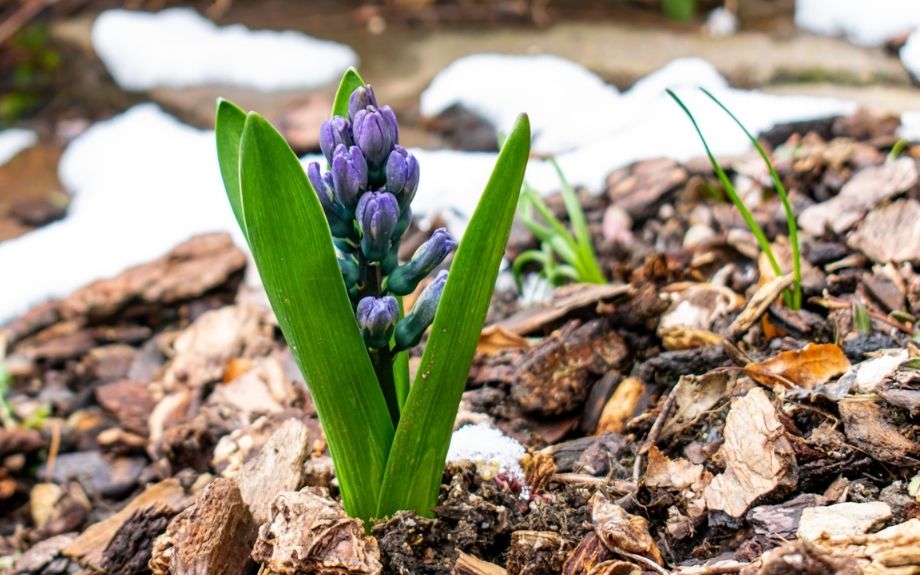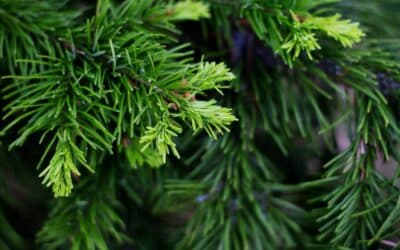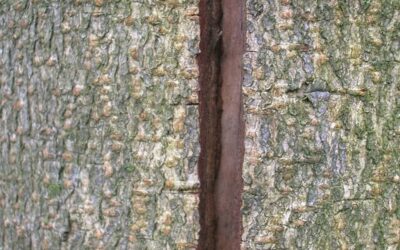Blog Topics
It’s a verb, it’s a noun, it’s mulch! We always hear how good mulch is for our plants but did you know that it’s also a major cause of death for trees? In fact, using mulch incorrectly can mean the end of your garden plants, shrubs, and trees.
That doesn’t mean you shouldn’t use mulch at all. After all, it truly is one of the most important additions you can make to your landscape. So keep reading to learn:
- what mulch is,
- which types of material to use (and which to avoid),
- how to use it in the landscape,
- what “mulch volcanoes” are (and why they’re bad!), and
- how to avoid landscape problems while getting all the benefits that mulch offers.
What is mulch?
Mulch is defined as any material used to cover the top layer of soil in order to:
- protect soil (such as from erosion),
- insulate soil (to regulate soil temperature),
- preserve soil moisture (so plants grow stronger),
- decorate soil (for a more pleasing or consistent appearance),
- enrich soil (for healthier plants), and/or
- discourage weed growth.
That’s a lot of benefits from something so simple!
What materials can you use for mulch?
Almost anything can be used as mulch. However, there are some materials that are more commonly used. These tend to be:
- readily available (either bagged or in bulk) and
- uniform in appearance (which is important when you want to replenish your mulch while keeping a uniform appearance).
On the other hand, there are also some materials to avoid using in your landscape (keep reading for details on that).
What’s the difference between organic and inorganic mulch?
Organic mulches are made from once-living things (usually, trees). Don’t confuse it with the term “organic” that’s used to describe crops grown without pesticides or herbicides – they’re not the same thing.
Inorganic mulch, by comparison, refers to mulch made from non-living things. The most common inorganic mulch is rock, such as gravel, smooth river rocks, or even rip rap.
What are the best choices for mulch?
The best option for mulching your landscape will depend on your preferences, budget, availability, plants, and more. But, generally, using organic mulch made from wood chips or bark will be the best choice. It’s one of the easiest and least expensive ways to ensure the long-term health and fertility of your soil and the health of your trees and shrubs. Readily available and made from plant material, wood mulch returns itself into the soil from which it grew. You can find wood mulch in a variety of formats.
Wood Chips
Wood chips are readily available, economical, and are a good way to give green waste a second life. Often made from downed trees, wood chips can be made on-site if you’re having a tree removed or several large trees pruned. Just ask your arborist.
Bark Chips
Bark chips are similar to wood chips but made exclusively from the ground bark of trees, such as Redwood, Douglas fir, or Cedar, and often graded by size.
Green Waste
Some municipalities make green waste mulch available for residents. This mulch is typically made from green waste accumulated by landscape crews and is a mix of different tree species’ bark, wood, and leaves, as well as untreated waste lumber.
Painted or Stained Wood Mulch
These colored mulches are usually made from milled lumber waste and contain only wood, with no bark, twigs, or leaves. The wood used in colored mulch is sprayed or tumbled with paint or stain to uniformly coat the wood chips’ surfaces.
Some people prefer colored wood mulches over the natural color of wood mulch. Others find that the vivid colors overwhelm the subtle colors and textures of their landscape designs. It’s a matter of preference. Just make sure that the paint used is non-toxic, and the wood has not been treated with pesticides or fungicides. It’s not always easy to get this information so, if in doubt, skip the colored wood products.
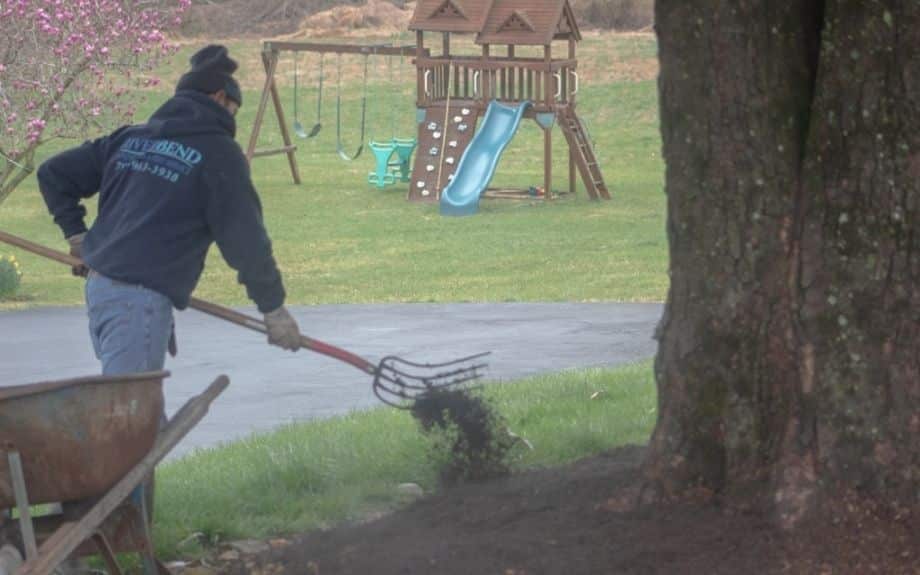
Wood mulch can be spread over bare soil or used to top up an existing mulch layer at any time of year (except when buried by snow or ice, of course!).
Doesn’t wood mulch “rob” nitrogen from the soil?
This is a common myth that has been thoroughly debunked. When used as a mulch (meaning that it’s spread on the soil surface, not mixed into the soil), wood chips have no effect on underlying soil nitrogen levels, except to increase them over time.
What about using rock?
Rock mulch, made of rough or tumbled stones, comes in various sieved sizes and a range of colors. Stone mulch is decorative and doesn’t break down at the rate organic wood chip mulch does, meaning you don’t have to replace it. It also doesn’t hold moisture the way wood chips and bark chips do.
Rock mulch is very heavy and will be more expensive by weight or volume than organic materials. Another thing to consider when choosing rock mulch is that it absorbs and retains heat; don’t use rocks over the root systems of plants and trees that can damaged by this.
Which materials should I avoid?
There are some mulch materials to avoid in your landscape. These include mulches made from petroleum products, such as plastic and synthetic (petroleum-based) rubber. The worst offenders are the following:
Plastic Sheeting
This is a readily available material, and some people use it as a landscape weed barrier. We do not recommend this, as plastic sheeting smothers your living soil instead of your weeds. While it may be cheaper or easier to find than alternatives, think twice before hiring someone who tells you plastic sheeting is a great solution for weeds.
Landscape Fabric
This lightweight fabric is designed with perforations that allow water and oxygen molecules to pass through it, as well as beneficial soil microbes and microscopic particles of minerals and organic matter.
On the other hand, it’s a synthetic material that does nothing to improve the soil. And, over time, makes the weed situation worse. Instead of suppressing weed growth, it allows weeds’ roots to grow through the fabric into the soil below. When you try to pull out the weed, you end up pulling up large pieces of landscape fabric as well, disturbing nearby plants and creating a mess. If you’ve ever tried to remove landscape fabric after a year or two, you know how difficult it is to pull out as it tears into strips and small pieces!
PRO TIP: If you are mulching to suppress weeds, a layer of overlapping cardboard sheets or heavy paper weed barrier under four or more inches of organic mulch will do a better job than plastic. The paper allows both air and water to move freely between the soil and the atmosphere while blocking the sunlight that stimulates weed seed germination. Protected beneath the mulch, cardboard and paper weed barrier will not rapidly break down as it would if exposed to sunlight.
Recycled Petroleum-rubber Mulch
This is another product to avoid. Made from used tires and petroleum rubber waste, rubber mulch is sold as a long-lasting weed suppressant and as a shock-reducing playground surface. But because these products may come from a range of untraceable source materials, they can contain heavy metals and toxic ingredients that leach into soil.
Equally important is the fact that this material will not break down and enrich the soil the way organic mulch will. It does not contribute to soil’s microbial growth, which is the basis for healthy, living soil. Plus, petroleum rubber can ignite and create toxic fumes.
One more thing to remember is that you’ll want to use some sort of barrier if you cover your soil with petroleum rubber mulch. This will prevent the rubber pieces from migrating into your soil. Usually, landscape fabric is used to create this separation.
How much mulch do I need?
A good rule of thumb for organic mulch is that it should be three inches deep, minimum. Spread it out so that it covers all bare soil in your landscape, being careful to keep it pulled away from plant stems.
If you multiply the square foot area of your garden by three inches (a quarter of a foot), you’ll get the amount of mulch you need in cubic feet, the measurement used for mulch quantities.
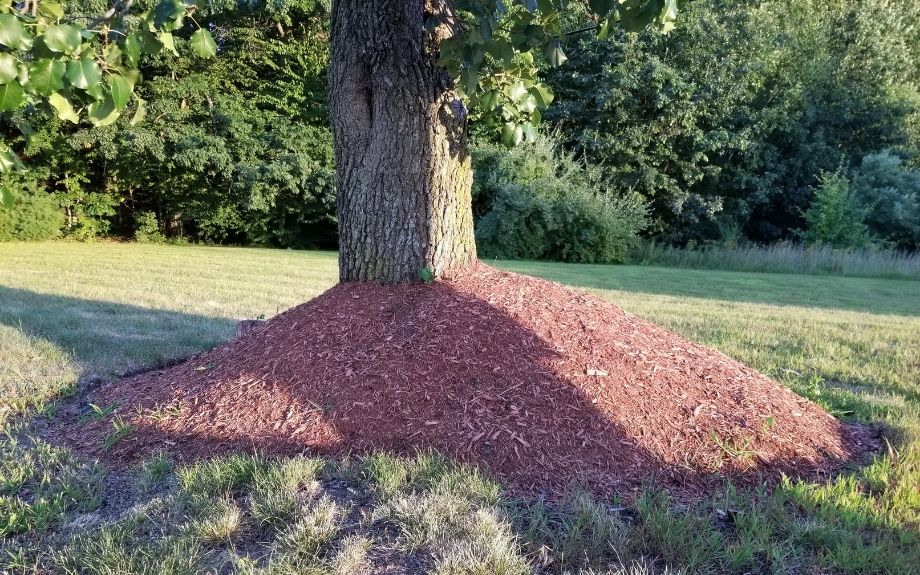
Mulch volcanoes like this one piled around a tree trunk will lead to decay, decline, and the eventual death of the tree.
Using Mulch – Do NOT Create a ‘Mulch Volcano’!
There is only one thing to avoid when using organic wood mulch and that is the mulch volcano.
Mulch volcanoes happen when mulch is piled up against the trunk of a tree or shrub. The pile forms a volcano-shaped collar around the trunk, often reaching several feet in height.
We recommend a good three- to five-inch layer of organic mulch over all bare soil, but never a pile of it! Always keep mulch away from the trunks of trees and shrubs. Instead of forming a mound, taper the layer’s depth down to zero as it approaches the trunk flare.
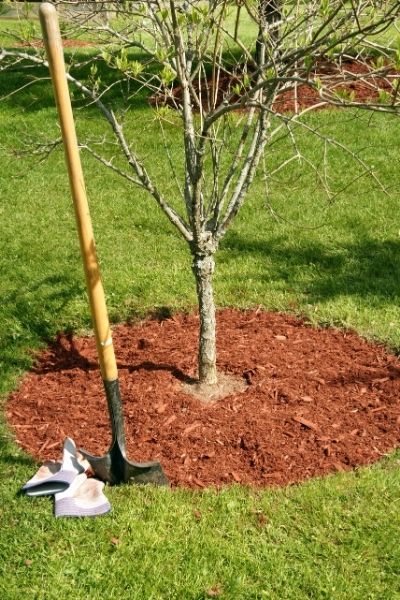
Colored wood mulch spread around a tree. Notice how it’s pulled away from the tree trunk.
How Mulch Volcanoes Kill Trees
Mulch volcanoes can be fatal to trees for two reasons: moisture and pathogens.
Organic mulch retains moisture naturally, which in itself is beneficial. And moisture and microbes both contribute to the breakdown of the mulch into humus and humic acid, enriching the soil. But when this moisture-retaining mulch is piled up against a tree’s trunk, it invites the kind of unwanted bacteria and fungi that can kill the tree.
Tree bark acts as a surface membrane that protects the tree’s internal system the way our skin protects us. But bark can be breached or compromised when it is kept wet from the mulch piled against it. The regular exchange of oxygen and carbon dioxide is also restricted, which contributes to decay.
Plus, the microbes in mulch which contribute to the mulch’s decay can also work to decay the bark that protects the tree.
This is especially important at the trunk flare (where the base of the trunk widens and becomes tree root tissue). Always keep this vital transition point clear to keep both bark and roots healthy.
So follow best practices and keep mulch away from the trunks of your trees and shrubs, while keeping a thick layer of it over the rest of your open soil.
We Can Help
If you have a large garden, buying pre-bagged mulch may be too expensive. Bulk mulch, delivered by truck, is less expensive overall. However, it requires equipment and hard work to get the mulch from its drop-off point at your curb to where it’s needed in your garden. If you can’t do this yourself or you don’t have enough time, we can help!
In addition to our tree pruning and landscape design services, we offer mulching and mulch replenishment. Whether you’re tucking your garden in for its winter sleep or preparing your plants for the long growing season, our crews can quickly and correctly mulch your landscape for you. We can set up a maintenance schedule for you so that your mulch is regularly replenished at the same time that your trees are pruned or sprayed, keeping your property looking its best all year round.
Give Us a Call at 703-402-9366
If you'd like help with your trees or landscape, have any questions, or would like to schedule an appointment with one of our Certified Arborists, please give us a call. We'd love to hear from you!

